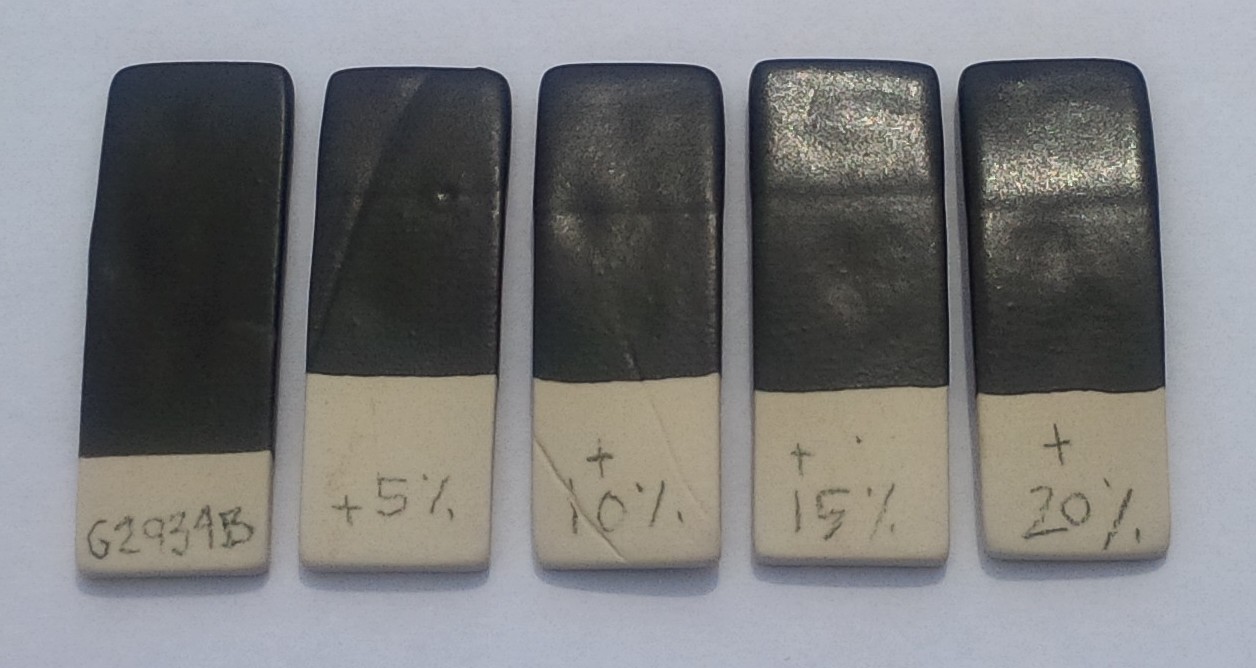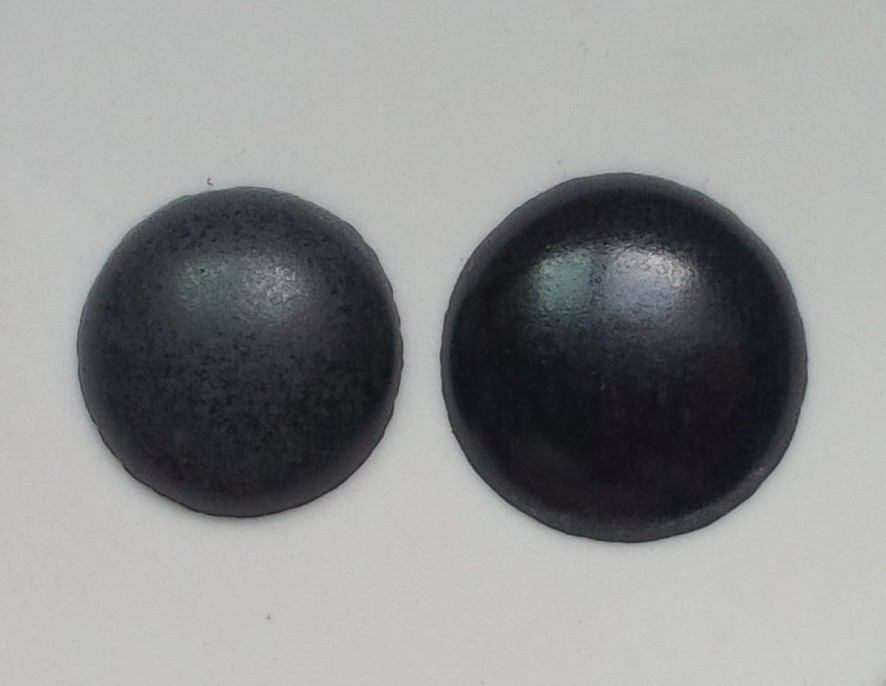| Monthly Tech-Tip | No tracking! No ads! | |
Triaxial Glaze Blending
In ceramics many technicians develop and adjust glazes by blending two, three or even four l materials or glazes together to obtain new effects
Key phrases linking here: triaxial glaze blending - Learn more
Details
An often employed a way to develop new (usually visual) glaze effects. There are many books and websites that cover this topic (and software to derive the recipe of the mixes). Triaxial is the most common form of blending (vs. linear, quadraxial). A factor that makes this type of blending easy-to-do is that corner or endpoints can be mixed as slurries (having equal specific gravities) and poured together by volume. Typically triaxial blend corners are labeled A, B and C. Mixes between corners, for example, A and B in the photos below, are termed 3A-1B (75% A, 25% B), 2A-2B (50% A, 50% B), 1A-3B (25% A, 75% B). Mixes in the center of the triangle contain all three corners, they are 2A-1B-1C, 1A-2B-1C and 1A-1B-2C.
In its most random instance, triaxial corner points are chosen from existing glazes that are unsuitable or extreme in some way (e.g. too matte, runny, not melted), with the hopes that somewhere within the blend will be a new interesting effect (choice of corner points is thus the key factor in the likelihood and finding a result). Materials (e.g. feldspar, silica, clay) are often blended to find the percentages at which they produce a good glass. In the most directed approaches, blends are done to fine-tune color, matteness, melt fluidity, etc.
Triaxial blending is about recipes. But people who know glaze chemistry (tempering that with knowledge of materials and minerals) employ blending techniques much less, often as a final step to fine-tune a recipe (after development by targeting or adjusting the chemistry). They see the discovery of glaze effects as much less a matter of chance and much more likely by empirical methods. No doubt you have seen web pages that describe ambitious blending projects, ones that end up with hundreds of fired glaze tiles that poorly comply with common sense recipe limits, how valuable are these really? As you might expect, at Digitalfire we promote this method of glaze development rather than triaxial blending.
That being said, an account at Insight-live.com is a great place to document this type of blending. Here is an scenario:
- Enter the recipes for each of the three corners and give them code numbers (for labeling fired specimens, e.g. 1234A, 1234B, 1234C).
- Link them to each other, then upload a quality picture to one of the three and link it to the other two.
- Put notes in each of the three recipes and in the picture.
- Link them to the firing schedule.
- Create a project to describe the objective and attach the three recipes to that project.
- After examining the fired triaxial decide which blends to try, then enter those as recipes (link the original three recipes or refer to their code numbers in the notes). For each include a zoomed-in picture of it on the triaxial and then add more pictures for subsequent firing tests. As each is mixed enter notes about the characteristics of the slurry and problems (e.g. settling, cracking during drying, poor application properties, etc). As each test tile is fired, upload a picture and enter notes about it.
If the triaxial is a mix of three materials rather than recipes, then modify the above by creating just one recipe and describing the blend in its notes and attaching the picture of the fired result to it.
Related Information
A triaxial blend of Gerstley Borate and two native clays

This picture has its own page with more detail, click here to see it.
The result is much less predictable than for blending existing known glazes, these reservoirs contain the runoff if the melted result is excessively fluid.
A triaxial blend of three glazes at cone 6

This picture has its own page with more detail, click here to see it.
A is a matte white, B is Rich Iron Red and C is a glossy white. Recipes 1 and 2 are 75% A, 6 and 10 are 75% B, 9 and 12 are 75% C. 3, 4 and 5 are 50% A, 3, 7 and 11 are 50% B. 5, 8 and 11 are 50% C. This blend was done in 1977 in the lab at Plainsman Clays.
Tuning the degree of gloss in a colored matte glaze

This picture has its own page with more detail, click here to see it.
Matte glazes have a fragile mechanism. That means the same recipe will be more matte for some people, more glossy for others (due to material, process and firing differences). In addition, certain colors will matte the base more and others will gloss it more. It is therefore critical for matte glaze recipes to have adjustability (a way to change the degree of gloss), both for circumstances and colors. This recipe is Plainsman G2934 base matte with 6% Mason 6600 black stain added. It has been formulated to be on the more matte side of the scale so that for most people a simple addition of G2926B (M370 transparent ultra clear base recipe) will increase the gloss. That means users need to be prepared to adjust each color of the matte to fine-tune its degree of gloss. Here you can see 5:95, 10:90, 15:85 and 20:80 blends of the matte:gloss recipe bases.
Tuning the degree of gloss on a matte black glaze

This picture has its own page with more detail, click here to see it.
These 10-gram balls were fired and melted down onto a tile. The one on the left is the original G2934 Plainsman Cone 6 MgO matte with 6% Mason 6600 black stain. On the right, the adjustment has a 20% glossy G2926B glaze addition to make it a little less matte. Notice the increased flow (the ball has flattened more) with the addition of the glossy. In addition, while the percentage of stain in the one on the right is actually less (because of the dilution of the transparent), the color appears darker! Tuning the degree of matteness when making color additions is not just for appearance, for functional ware it is also about achieving a surface that does not cutlery mark and is not leaching heavy metals.
Links
| Articles |
Chemistry vs. Matrix Blending to Create Glazes from Native Materials
Is it better to do trial and error line and matrix blending of materials to formulate glazes or is it better to use glaze chemistry right from the start? |
| Glossary |
Glaze Chemistry
Glaze chemistry is the study of how the oxide chemistry of glazes relate to the way they fire. It accounts for color, surface, hardness, texture, melting temperature, thermal expansion, etc. |
| Glossary |
Trafficking
At Digitalfire we use the term "recipe trafficking" to describe the online trade in ceramic and pottery glaze recipes that can waste your time and cost you lots of money. Better to learn to understand glazes. |
| Glossary |
Limit Recipe
This term refers to sanity-checking ceramic glaze recipes by noting whether materials present or their relative percentages fall outside typical norms for functional ware. |
| URLs |
https://www.glazespectrum.com
500 fired tests of base glazes with oxide additions by Helen Partridge Love These fired samples were two years in the making and represent the best of data she collected over many years. They are intended as a teaching tool to inspire people to experiment themselves. |
| By Tony Hansen Follow me on        |  |
Got a Question?
Buy me a coffee and we can talk

https://digitalfire.com, All Rights Reserved
Privacy Policy
